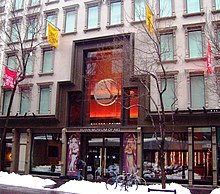Rubin Museum of Art

Exterior seen from 17th Street (February 2011)
|
|
| Established | October 2, 2004 |
|---|---|
| Location | 150 West 17th Street Manhattan, New York City |
| Coordinates | 40°44′24″N 73°59′52″W / 40.7401°N 73.9978°W |
| Type | Art museum, education center, performance and event venue |
| Collection size | 2,000+ objects |
| Public transit access | |
| Website | rubinmuseum |
Bus:
M1, M2, M3, M7, M14A, M14D, M20, M55
Subway:
The Rubin Museum of Art is a museum dedicated to the collection, display, and preservation of the art and cultures of the Himalayas, India and neighboring regions, with a permanent collection focused particularly on Tibetan art. It is located at 150 West 17th Street between the Avenue of the Americas (Sixth Avenue) and Seventh Avenue in the Chelsea neighborhood of Manhattan in New York City.
The museum originated from a private collection of Himalayan art which Donald and Shelley Rubin had been assembling since 1974. In 1998, the Rubins paid $22 million for the building that had been occupied by Barneys New York, a designer fashion department store that had filed for bankruptcy. The building was remodeled as a museum by preservation architects Beyer Blinder Belle. The original six-story spiral staircase was left intact to become the center of the 25,000 square feet (2,300 square metres) of exhibition space.
The museum opened in October 2004, and displays more than 1,000 objects including paintings, sculpture, and textiles, as well as ritual objects from the 2nd to the 20th centuries. The new facade on 17th Street and the five floors of galleries were influenced by Tibetan art, and were conceived by New York-based museum architects Celia Imrey and Tim Culbert. Its graphic identity was conceived by graphic designer Milton Glaser.
...
Wikipedia


